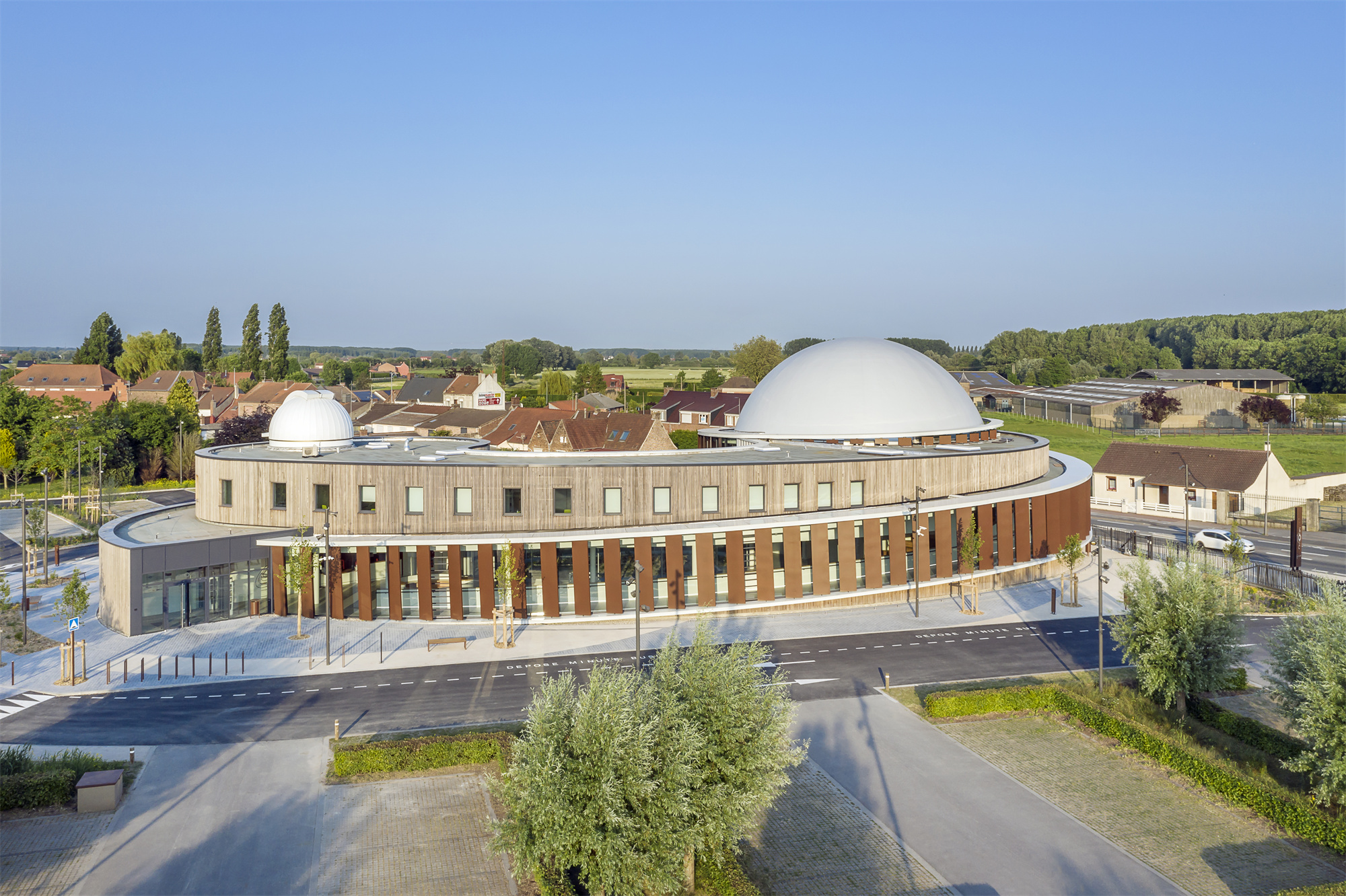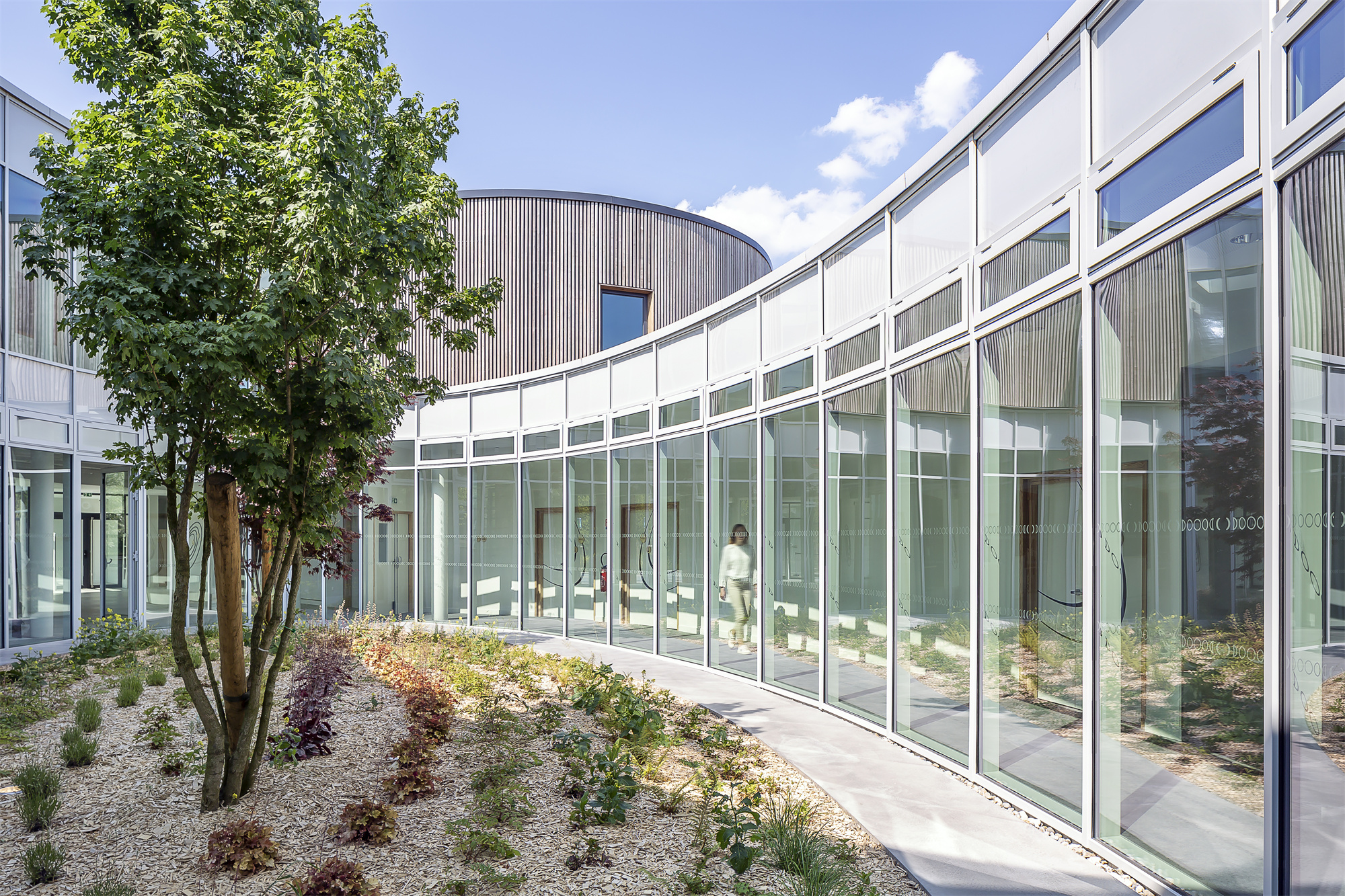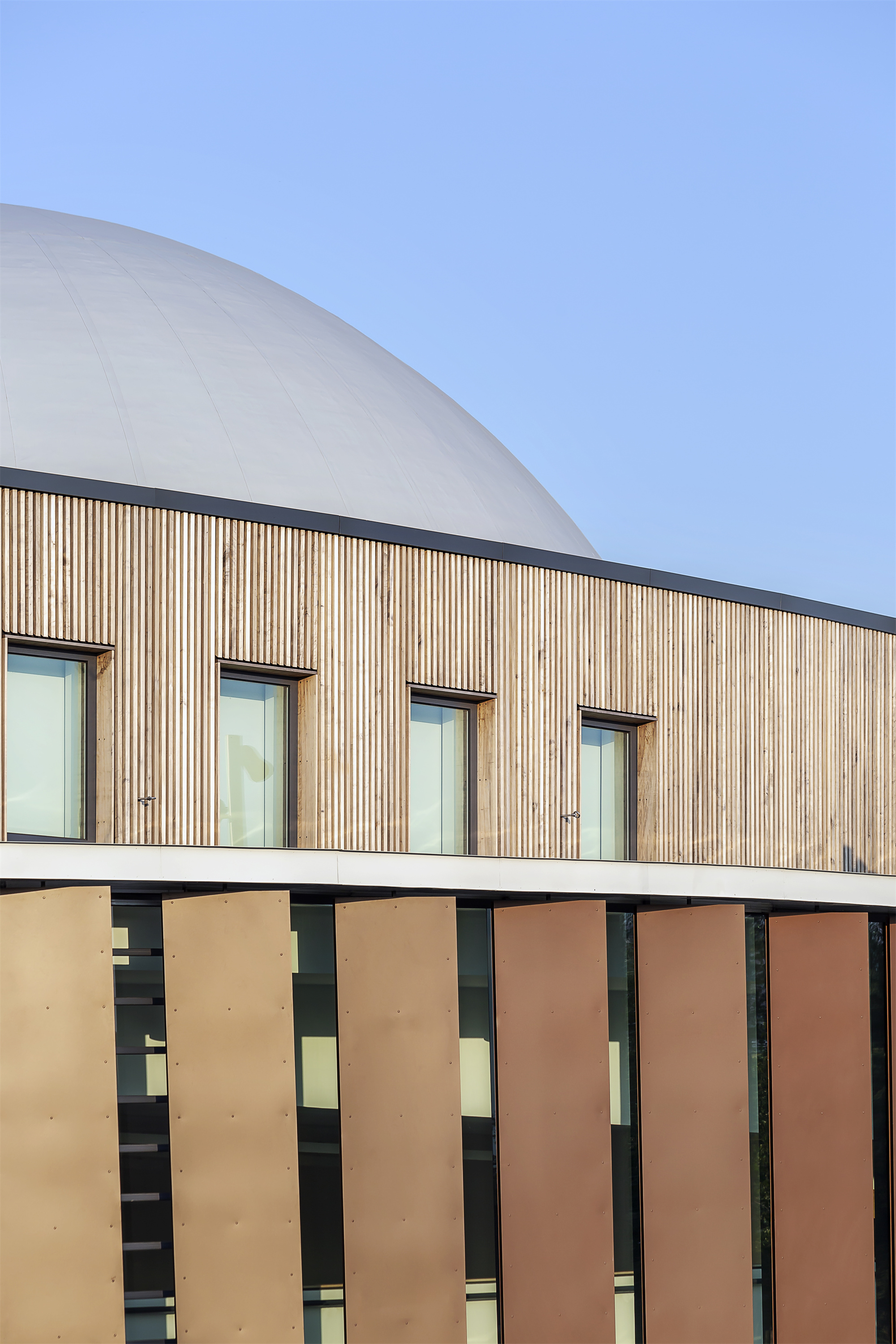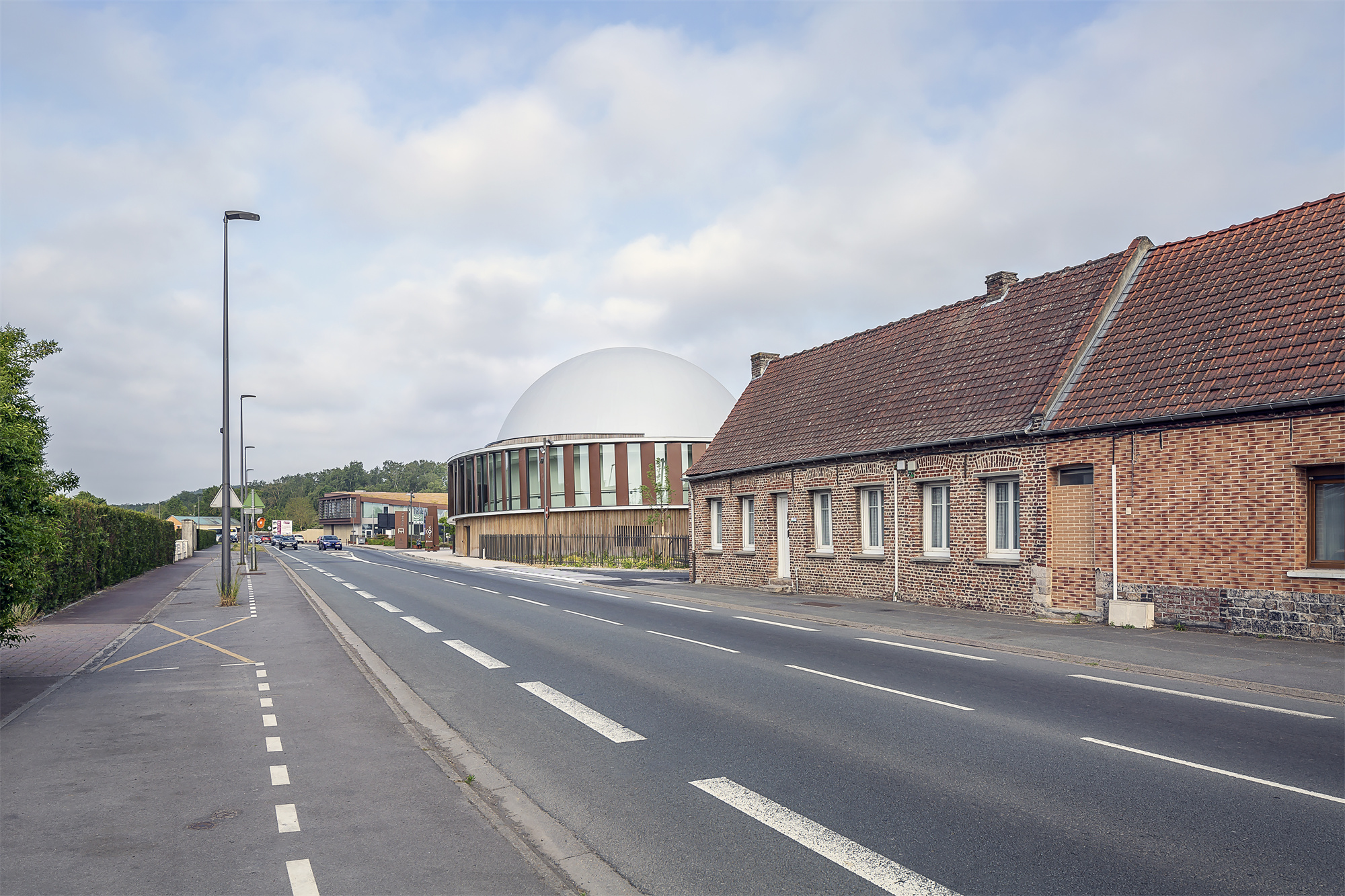

设计单位 Snøhetta
项目地点 法国北部杜埃市
建成时间 2023年5月
建筑面积 2000平方米
本文文字由设计单位提供。
Orionis天文馆和天文台是法国北部杜埃市的一个新文化目的地。它的设计灵感来自行星持续运动的椭圆形轨迹。
Snøhetta completes new planetarium and observatory in France.The planetarium and observatory named Orionis is a new cultural destination in the city of Douai in northern France, inspired by the elliptical and continuous movement of the stars.
该项目坐落于斯卡尔普河、Arkéos考古博物馆和附近的住宅区之间。Snøhetta团队希望和谐自然地串联场地资源与景观,为本地居民和游客创造一个容易抵达、激发灵感的文化空间。因此,该项目是一座统一的建筑,其曲线环绕着放映室和天文台的两个圆顶。
Situated on a remarkable site, between the adjacent Scarpe river, the archaeological museum Arkéos and a nearby residential complex, the project aims to harmoniously connect these elements and create an accessible and inspiring space for visitors. Snøhetta’s design is a unified building with curves that wrap around the two domes of the projection room and the observatory.
Snøhetta与CET Ingénierie、Impact Conseil et Ingénierie、Cicanord、Studio Dap和Atelier Silva Landscaping密切合作,自2019年底以来一直致力于设计该建筑,并且见证了该项目从概念到施工的整个过程。Orionis天文馆于2023年5月13日向公众开放。
In close collaboration with CET Ingénierie, Impact Conseil et Ingénierie, Cicanord, Studio Dap and Atelier Silva Landscaping, Snøhetta has been working on the building since late 2019, seeing the project through from concept to construction. Orionis opened to the public on the 13th of May 2023.


椭圆是永恒且流动的形状
事务所联合创始人Kjetil Trædal Thorsen解释道:“我们想为杜埃居民提供一个非同寻常的聚会场所和新目的地。Orionis天文馆的设计灵感来自于行星的椭圆运动轨迹。在该项目中,我们重新诠释了连续、流动和永恒的概念,不仅体现在建筑轮廓上,还体现在每一位游客在馆内的五感体验。”
“We wanted to propose an extraordinary meeting place and a new destination for the inhabitants of Douai. The architectural and urban concept of our project takes its inspiration from the elliptical movement of the stars. Being continuous, fluid and perpetual are notions that we have reinterpreted in the project, not only in terms of the shape but also in the experience that visitors will have of the planetarium, all senses employed” explains Kjetil Trædal Thorsen, co-founder of Snøhetta.
连续流动的设计理念贯穿了整个项目,也体现在了接待区、展览空间、圆形剧场、建筑圆顶等空间的设计上。建筑之间通过一个略微倾斜的坡道相连接,人们能够从建筑局部半透明的外立面看到坡道。
The concept of continuous movement has inspired the project throughout, defining everything from the reception area, the exhibition spaces, the amphitheater, and the domes of the building. The building is linked by a slightly inclined ramp, visible from the outside through the building’s partly translucent façade.


融入当地环境
永恒的概念还体现在与斯卡普河和周围景观相互呼应的设计中。这些景观在视觉上与天文馆交织在一起。天文馆的设计与Arkéos博物馆无缝衔接,并共享了景观资源和停车场,设计团队希望将这两个文化建筑连接起来。
The notion of timelessness is also found in the continuous movement of the Scarpe river and the surrounding landscape that weaves a physical and visual link to the planetarium. It is designed to integrate seamlessly with the Arkéos Museum and shares landscaped areas and parking lots intended to connect these two cultural entities.
这两个圆顶的设计目的是能够使人们从远处看到的视觉标志,同时又不会对当地社区造成影响。设计团队的目标是通过建筑的形式从外部揭示建筑的功能。
The two domes aim to be a visual signal that can be seen from afar while not impacting the local neighborhood. Snøhetta’s goal was to reveal the building’s program and function from the exterior through its shapes.


室外空间的设计有两个鲜明的特点:周围的景观和椭圆形的内部庭院。这两者都有助于创建一个连贯且具有场景化的文化目的地。设计团队充分利用场地的特点,同时结合周围景观,使得建筑与环境无缝融合。
The design of the outdoor spaces has two distinct characters; the surrounding landscape and an elliptical interior courtyard. Both help to create a coherent and contextualized cultural destination that takes advantage of the outstanding features of the site while integrating seamlessly with the surrounding landscape.


将景观与周围环境相呼应
景观设计意在促进生物多样性,并整合现场的材料。花园有一条连续的通道,连接建筑的各个室外空间。这条小路采用了比利时的天然青石,提供了额外的质感和视觉表现力。此外,植被搭配也是经过精心布置,使得停车位和前院融为一体。
The landscape is designed to promote biodiversity and integrates the materials present on the site. The garden has a continuous pathway that connects various outdoor spaces and the building. The path is paved with natural bluestone from Belgium, providing an additional layer of texture and visual expression. Also, plants and trees are strategically placed to integrate the parking spaces and the forecourt.
屋顶种植了野草,营造出自然有机的视觉元素,在建筑内部非常醒目。进入建筑物内部后,所有的内部空间都可以看到种植的植被和玻璃的天井,它作为一个安静的室外空间,为人们提供了与室外自然景观的联系。
The roof is planted with wild grass, creating a natural and organic visual element that is highly visible inside the building.Once inside the building, the planted and glazed patio is visible from all interior spaces and works as a calm outdoor space, providing a connection to the natural landscape outside.




以人为本是项目的核心
建筑设计满足了许多用户的需求,并与天文馆的整体主题保持一致性和连续性。
The design of the building addresses the needs of the many users maintaining a sense of coherence and continuity with the overall theme of the planetarium.
游客的参观路线从入口处流畅地穿过礼品店和展览空间,一直延伸到沉浸式空间。然后,斜坡缓缓地将观众引导回地面层和出口处。
The visitor circuit flows smoothly from the entrance, through the gift shop and exhibition space, all the way to the immersive room. Then, the ramp gently brings the audience back down to the ground floor and towards the exit.
在特定区域设有专用通道,以确保人流不会交叉,例如观景台区域和一楼的办公室。
Specific areas have dedicated access to ensure that the flows do not intersect, such as the observatory area and offices on the first floor.




材料的特性是关键要素
天文馆外围护结构的设计灵感来自于周围地区以及附近建筑(如考古博物馆和砖房)的使用材料。该项目由三种主要颜色组成:白桦树不断变化的木色、钢制栏杆的铁锈色以及放映室穹顶采用PVC膜的浅灰色。
The planetarium's exterior envelope is inspired by the surrounding region and the materials used in nearby buildings such as the Arkéos Museum and brick houses. The project is composed of three main colors: the evolving wood color of the poplar, the rust color of the steel brise-soleils, and the light gray PVC membrane that covers the dome of the projection room.


主立面幕墙前采用了钢板颜色和木质壁板,灵感来源于考古博物馆,由此形成了与环境融为一体的连贯式设计。
The color of the steel panels in front of the curtain walls on the main façade and wood siding, both inspired by the Arkéos Museum, contribute to a cohesive design that blends with the environment.
靠近邻近地块的低层屋顶种植了植被,增添了自然元素,有助于将项目融入现有的场地景观中。放映室的穹顶覆盖着一层浅灰色的 PVC 薄膜,减少了对人们视觉的冲击,并强调了绕过外墙的坡道。
The roof of the lower level near the neighboring parcels is vegetated, adding a natural element that helps integrate the project into the existing site landscape. The screening room dome is covered with a light gray PVC membrane, reducing its visual impact and enhancing the path of the ramp that winds around the façade.




可持续发展的雄心
可持续性设计在项目中发挥了重要作用。例如,展厅地板的供暖由地热能提供,冬季供暖,夏季制冷。此外,还在建筑的多个开口处安装了传感器,以此实现智能的自然通风。最后,遮阳板和绿色屋顶也有助于为建筑提供良好的室内热舒适环境。为了减少建筑的碳足迹和施工现场对环境的影响,我们优先选择了当地的材料进行建造。
Sustainability played an important role in the design of the project. The heating for the showroom's floor is supplied by geothermal energy, and it provides heating for the building during the winter and cooling during the summer. Additionally, sensors are installed on multiple openings to allow for intelligent natural ventilation. Finally, the sunshades and the green roof also contribute to a responsible regulation of the building's temperature and rainwater. Locally sourced materials were preferred to limit the carbon footprint and allow for a low environmental impact construction site.


设计图纸 ▽


完整项目信息
Location: Douai, northern France
Client: Douasis Agglomeration
Timeline: September 2019–May 2023
Size: 2000㎡
Architecture and Interior Architecture: Snøhetta
Building engineer: CET Ingénierie
Environnemental engineer: Impact Conseil et Ingénierie
OPC: Cicanord
Acoustic engineer: Studio Dap
Landscape: Atelier Silva Landscaping and Snøhetta
Credit of photos: Jad Sylla
版权声明:本文由Snøhetta授权发布。欢迎转发,禁止以有方编辑版本转载。
上一篇:集体居住:20世纪“先锋”公寓建筑 | “经典再读”公寓合集
下一篇:被光线与空间拥抱:日本“T之家”独栋住宅 / Katsutoshi Sasaki + Associates